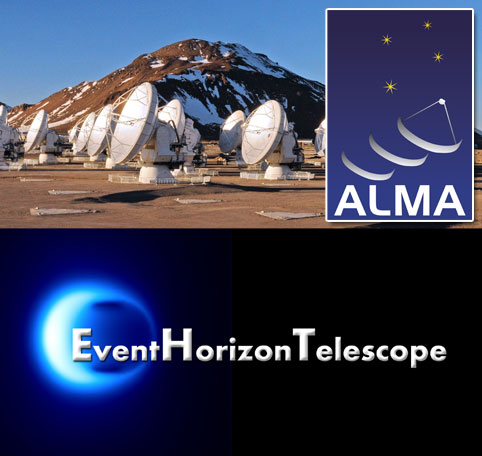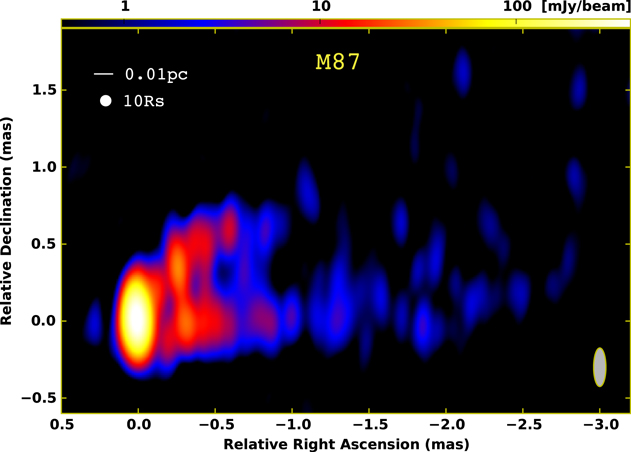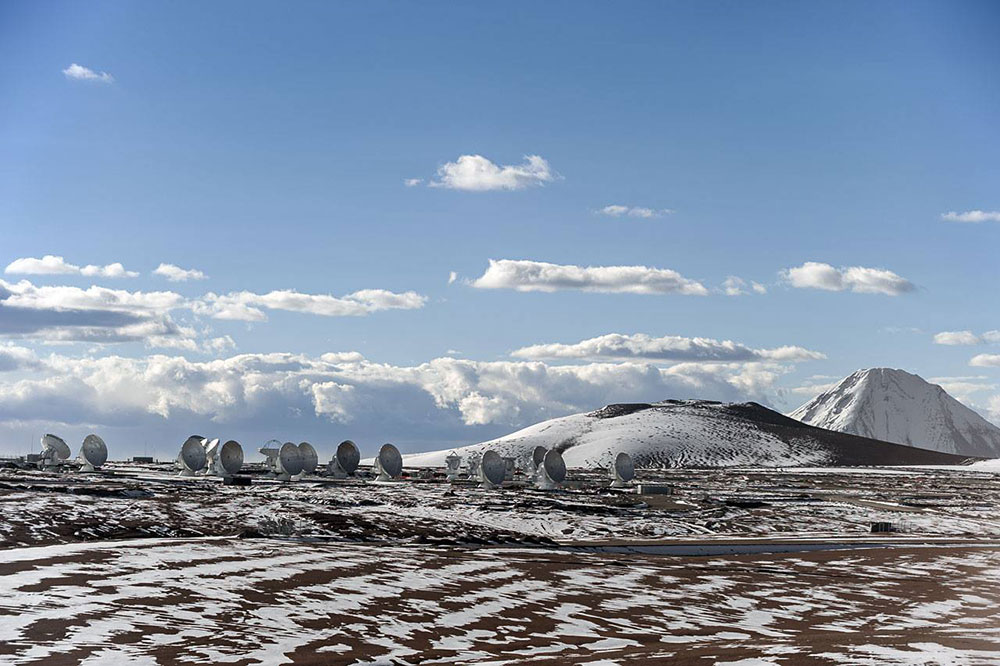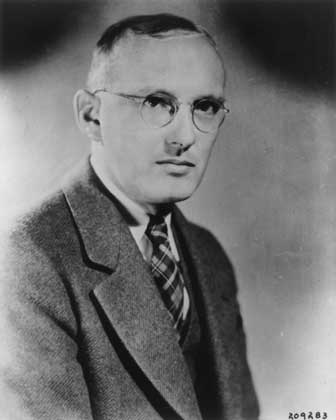NRAO eNews
Volume 9, Issue 2
24 February 2016
NRAO eNews
Volume 9, Issue 2 • 24 February 2016

Upcoming Events

NRAO Live! (Boston)
Mar 7 - 8, 2016 | Boston, MA

NRAO Live! (Texas)
Mar 10, 2016 | Austin, TX

5th VLA Data Reduction Workshop
Mar 14 - 18, 2016 | Socorro, NM

NRAO Live! (Wisconsin)
Mar 15 - 16, 2016 | Madison, WI

2016 NRAO Postdoctoral Symposium
Mar 28 - 29, 2016 | Green Bank, WV

NRAO Live! (Carnegie Observatories)
Mar 31, 2016 | Pasadena, CA

Molecular Gas in Galactic Environments
Apr 4 - 7, 2016 | Charlottesville, VA

15th Synthesis Imaging Workshop
Jun 1 - 8, 2016 | Socorro, NM

Half a Decade of ALMA: Cosmic Dawns Transformed
Sep 20 - 23, 2016 | Indian Wells, CA
Registration Open for Synthesis Imaging Workshop

The 15th Synthesis Imaging Workshop will be held 1-8 June 2016 at the NRAO and the New Mexico Institute of Mining and Technology in Socorro, New Mexico. The workshop will comprise a week of lectures on aperture synthesis theory and techniques at a level appropriate for graduate students in astrophysics. The workshop will also include two days of practical tutorials demonstrating data collection, calibration, and imaging of data from the Very Large Array, Atacama Large Millimeter/submillimeter Array, and the Very Long Baseline Array.
The workshop web site provides additional information on scheduled lectures and events. Registration is now open and will continue on a first come, first served basis until the limit of 150 participants is reached.
For participants attending from outside the U.S., our understanding of current policy is that attending a scientific workshop in the U.S. should only require a visitor visa. Should you need a letter of invitation, please select that option when registering. We strongly encourage you to start paperwork early.
The National Radio Astronomy Observatory, the New Mexico Institute of Mining and Technology, and the University of New Mexico sponsor the Synthesis Imaging Workshop.
1mm VLBI Pre-Announcement

NRAO is pleased to announce that the call for 1mm Very Long Baseline Interferometry (VLBI) proposals to use phased ALMA at Band 6 in Cycle 4, in collaboration with the Event Horizon Telescope Consortium (EHTC), will be released to coincide with the ALMA Cycle 4 Call for Proposals in March 2016. The EHTC is expected to comprise the Submillimeter Array, the James Clerk Maxwell Telescope, the Submillimeter Telescope, the Atacama Pathfinder Experiment, the South Pole Telescope, the Large Millimeter Telescope Alfonso Serrano, the IRAM 30m telescope, and an antenna from the Northern Extended Millimeter Array.
The same scientific justification must be submitted in response to the ALMA and VLBI network calls. NRAO will facilitate this for the 1mm VLBI call by having proposers submit a copy of their ALMA Cycle 4 proposal in response to the 1mm VLBI call, approximately one week after the ALMA proposal deadline in April.
Further details, along with technical information for phased ALMA and the EHTC, will be made available with the 1mm VLBI Call for Proposals. It is expected that observing will take place in March or April 2017, when ALMA will be in a compact configuration suitable for efficient phasing.
First VLBI results from the GBT at 3mm

This (VLBA+GBT) 86 GHz false-color total intensity image of the M87 jet was produced by combining the visibility data from 2014 Feb 11 and Feb 26. The restoring beam is at bottom-right. The peak intensity is 500 mJy/beam.
[click to enlarge]
The first publication using the Green Bank Telescope (GBT) for Very Long Baseline Interferometry (VLBI) measurements at 85 GHz has just appeared. Hada et al. combined eight VLBA antennas with the GBT to study the relativistic jet emanating from the central black hole of the galaxy M87. The large collecting area of the GBT, together with a new NRAO wide-band recording system, produced an image of unprecedented quality, with a dynamic range 10x greater than previous M87 images in this band. The sensitivity of the GBT allowed for detection of correlated flux densities below 100 mJy on the longest baseline.
These M87 observations resolve details of the jet formation and collimation structure to ~10 Schwarzschild radii (Rs). The jet has an opening-angle near the black hole as wide as 100 degrees, the broadest opening angle in any astrophysical jet. A limb-brightened structure is already well developed at < 28Rs and a complicated jet launch shape at < 100Rs indicates multiple collimation stages. Some polarized features are observed near the jet base with a fractional polarization up to ~20%, the highest value ever seen on parsec-to-subparsec scales of this jet.
These results show that the GBT is a powerful addition to our astronomical capabilities for high-resolution measurements in the 3mm band.
Reference
High-sensitivity 86 GHz (3.5 mm) VLBI Observations of M87: Deep Imaging of the Jet Base at a Resolution of 10 Schwarzschild Radii, Kazuhiro Hada (NAOJ, INAF), et al., 2016, ApJ, 817, 131.
NAASC Workshop on Molecular Gas in Galactic Environments

The NRAO – North American ALMA Science Center (NAASC) is organizing a science workshop titled Molecular Gas in Galactic Environments that will be held 4 – 7 April 2016 in Charlottesville, Virginia, USA. Registration is available at the 2016 NAASC Workshop website until 14 March, and the hotel reservation deadline is 20 March. Registration includes the workshop materials, daily breakfast, breaks, and a welcome reception. An optional conference dinner is also available.
The spectral line sensitivity and spectral grasp of the Atacama Large Millimeter/submillimeter Array (ALMA) have resulted in the identification and imaging of more than 40 molecules outside the Milky Way. This international Workshop will focus on the character of the molecular gas in the varied environments in which these molecules are found beyond our Galaxy and will bring together ALMA, Very Large Array (VLA) and Green Bank Telescope users and potential users of future facilities – a next-generation VLA, the James Webb Space Telescope, the Thirty Meter Telescope, etc. – to consider what capabilities or upgrades to these instruments might best facilitate the study of extragalactic molecules.
Major topics of discussion at this NAASC Workshop will include:
- Exploring the relationship between molecular distributions and physical processes in galaxies
- Investigating the roles of molecular variation in extreme metallicity environments
- Examining the existence and cause of isotopic gradients within galaxies
- Scrutinizing variations in molecular excitation, both rotational and vibrational
- Seeking evidence for and causes of molecular abundance gradients
- Identifying molecules useful as probes of nuclear infall and outflow
- Determining the prospects of molecules as probes of black hole masses.
Confirmed invited speakers for this Workshop include:
- Francesco Costagliola (Chalmers, Onsala Space Observatory)
The molecular complexity of galaxies: opportunities and challenges in the ALMA era - Nanase Harada (Academia Sinica, Taiwan)
Chemical model of the circumnuclear disk around an active galactic nucleus - Christian Henkel (Max Planck Institute for Radio Astronomy)
Nucleosynthesis and molecular isotope ratios in extragalactic systems - Leslie Hunt (INAF-Osservatorio Astrofisico di Arcetri)
Molecules in low-metallicity starbursts - Takuma Izumi (University of Tokyo)
ALMA observations of circumnuclear feedback and feeding in nearby Seyfert galaxies - Adam Leroy (Ohio State University)
Molecular gas in high detail in nearby galaxies - Sergio Martin (Joint ALMA Observatory)
The unbearable opaqueness of compact obscured nuclei - Gergö Popping (European Southern Observatory)
Sub-mm emission in cosmological simulations: theoretical challenges and predictions - Dominik Riechers (Cornell University)
Detailed studies of cold gas and star formation in the early universe - Nick Scoville (California Institute of Technology)
Conference summary & perspectives - Jean Turner (University of California, Los Angeles)
TBA
We look forward to seeing everyone in Charlottesville in April!
ALMA Program News

The Joint ALMA Observatory antennas atop the Chajnantor Plateau in northern Chile's Atacama Desert. The 5920-meter elevation Licancabur volcano is visible in the background.
[click to enlarge]
ALMA entered a one-month observing hiatus at the end of January during the altiplanic winter period of poor weather. Software and equipment upgrades will be installed during this period. Antennas will be moved from the compact array deployed in January to the next most extended array for the continuation of high priority projects beginning 1 March.
The ALMA Cycle 4 Call for Proposals will be issued 22 March 2016, with a deadline of 21 April for proposal submission. Large Programs will be offered for the first time. Guidelines for preparation of proposals for Large Programs – projects that request more than 50 hours of observations – were published on the ALMA Science Portal on 1 February 2016. It is anticipated that 3000 hours will be offered for the 12m Array and 1800 hours for the Atacama Compact Array (ACA) in Cycle 4. Up to 15% of this time may be allocated to Large Programs: 450 hours for the 12m Array, and 270 hours for ACA stand-alone. The planned dates for ALMA configurations during Cycle 4 are described in the Science Portal article.
Most of last fall’s long baseline ALMA high priority projects have been delivered to Principal Investigators for their scrutiny. Many of these results will likely be presented in the international ALMA science conference, Half a Decade of ALMA: Cosmic Dawns Transformed, which will be held in Indian Wells, California from 20-23 September 2016. Registration for the conference will open on 11 April.
The NAASC Workshop Molecular Gas in Galactic Environments will be held in Charlottesville, Virginia 4-7 April 2016 and will focus on the character of the molecular gas in the varied environments in which these molecules are found beyond our Galaxy. Though abstract submission is now closed for the Workshop, registration will remain open until 14 March.
ALMA Development studies for FY2016 were announced in the December 2015 eNews. NRAO expects to issue a new Call for Proposals for Development Studies on 1 March 2016. The period of performance for funded Studies will run about one year, from 1 October 2016 to no later than 30 September 2017. The Reports from previous Calls are available on the web page for the Call to inform future submissions.
CASA Releases 4.5.1 and 4.5.2

We are pleased to announce releases 4.5.1 and 4.5.2 of the Common Astronomy Software Applications (CASA) package.
The CASA package is being developed by NRAO, ESO, and NAOJ and is used for the offline reduction and analysis of Atacama Large Millimeter/submillimeter Array (ALMA) and Very Large Array (VLA) data. CASA is fully scriptable. Full support is provided for ALMA and VLA, but almost any data that can be written in uvfits format can be imported and reduced in CASA, such as data from the Combined Array for Research in Millimeter-wave Astronomy, Submillimeter Array, and Australia Telescope Compact Array.
CASA 4.5.1 and CASA 4.5.2 are available from the CASA homepage. Please follow the links to "Obtaining CASA".
Supported OSs are:
- Linux (64bit): RedHat 5 and 6
- Mac OS: 10.9 and 10.10
CASA 4.5.1 is a patch to the CASA 4.5.0 release. The most significant additions in this release are a new ALMA pipeline, a bug fix in setjy that corrects the labels for J2000-to ICRS conversion of solar system ephemerides, and improved tclean performance.
CASA 4.5.2 is a second patch building upon CASA 4.5.1. The additional changes mostly affected the ALMA pipeline, in particular, to accommodate updated observing strategies. This release also fixes a bug in tclean to create a primary beam when using chanchunks, and addresses some edge cases in plotbandpass.
We recommend CASA 4.5.2 for most users. CASA 4.5.1 is being provided to support those ALMA projects which were reduced using the 4.5.1 patch.
We encourage you to subscribe to either or both of the following subscription lists:
Subscribe to Casa-announce for announcement of new releases, workshops, etc.
Subscribe to Casa-users for rapid notification of critical bugs and code updates.
If you have any questions, please consult the NRAO helpdesk or the ALMA helpdesk for all ALMA-related questions. CASA also has an on-line discussion forum.
2016 Jansky Lecture Nominations

The National Radio Astronomy Observatory invites nominations for the 2016 Jansky Lectureship. The Karl G. Jansky Lectureship is an honor established by the Trustees of Associated Universities, Inc. to recognize outstanding contributions to the advancement and public appreciation of radio astronomy. First awarded in 1966, it is named in honor of Karl G. Jansky who first detected radio waves from a cosmic source. For more information, visit the Jansky Lectureship website.
Please e-mail your nomination, including a concise justification for your choice, to J.J. Utley by Friday, 4 March 2016.
NRAO Forges Agreement with new South African Astronomy Institute

NRAO and the Inter-university Institute for Data Intensive Astronomy (South Africa) have signed a Memorandum of Understanding (MoU) to collaborate on algorithm and software development in support of forthcoming surveys on the Jansky Very Large Array (VLA) and MeerKAT.
Several next generation all-sky surveys in the 1-5 GHz range are planned in the next few years with wide-band telescopes, including the VLA in the U.S. and MeerKAT in South Africa. Pilot observations with the VLA are underway and Early Science with MeerKAT is scheduled to begin later this year, with full operations in late 2017.
These surveys will be pathfinders for the scientific direction and technical challenges of even larger surveys with the Square Kilometre Array (SKA) in the future. Due to high sensitivity, wide field-of-view, and relatively low frequencies, these surveys require high fidelity and in some cases, high dynamic range imaging. This requires use of compute-intensive imaging algorithms to correct for multiple direction-dependent effects including corrections for non-coplanar baselines and antenna primary beams as a function of time, frequency and polarization. These surveys will also generate PetaByte-scale data volumes.
Processing data from such surveys therefore poses the combined problem of Big Data and High Performance Computing. Advanced imaging algorithms required for these surveys are currently being tested for release in the Common Astronomy Software Applications (CASA) software package. Software for processing large data volumes using compute-intensive imaging algorithms on high performance computing platforms and pipeline processing, where possible, are also under development.
Making these solutions robust and reliable for automatic processing of these data-intensive surveys requires more research and development for scientific computing and related computer science problems, and use of large massively parallel hardware computing platforms to test and deploy the software solutions. Students, postdoctoral fellows and scientists with multidisciplinary skills thus become crucial components in realizing the full scientific potential of such surveys and the involved telescopes.
The Jansky VLA and MeerKAT have a large overlap in the parameters of the telescope and the planned surveys. Both telescopes therefore also have high synergy in the required post-processing technical solutions. In January 2016, to pool the available expertise and resources, NRAO and the inter-university Institute for Data Intensive Astronomy (IDIA) in South Africa completed an agreement to work together to explore the research and development challenges, and to build the data processing solutions within NRAO’s CASA software environment.
IDIA is a new South African institute established as a collaboration of three research-intensive universities engaged in MeerKAT large survey programs and SKA pathfinder projects: University of Cape Town, University of the Western Cape, and North-West University. A primary goal of the IDIA is to develop capacity for data processing and build data science solutions for processing and analysis of the large data sets from MeerKAT. Scientists, developers, postdocs and students at NRAO and IDIA will collaborate on algorithm development, and deploy and test the solutions on data-centric high performance computing platforms with the intent to provide the project teams for next generation surveys with the tools to process and analyze the large data sets in time for the data onslaught.
IDIA has begun acquiring hardware for large compute clusters located at the University of Cape Town that will be available for development and testing of parallel processing solutions in CASA. Developers and post-docs will be hired at IDIA later this year to begin collaborative software development of mutual interest in the CASA software system. Exchange visits from personnel at both ends are expected to also begin later this year and continue in the coming years. A work plan and processes to track the work is also being developed.
Recent Media Releases
Career Opportunities
Radar Tracking Engineer (Open Rank): The NRAO invites applications for a Radar Tracking Engineering position in Green Bank, West Virginia. The successful applicant will assist in the design, development, and operation of radar tracking using the 100-meter Robert C. Byrd Green Bank Telescope. This position is for a scientist, engineer or related discipline to help lead the radar initiative and collaborate with the Green Bank management, engineers, scientists, technicians, and other staff involved in other radar-related work on-site.
Assistant Scientist/ A: The NRAO is accepting applications for an Assistant Scientist/A position for the Magdalena Ridge Observatory Interferometer in Socorro, NM. The focus of this position is the investigation of combined optical-radio observations that could provide enhanced measurements compared to those made in a single portion of the electromagnetic spectrum. The work will be technical and will advance the state-of-the-art. The program will begin with a survey of current capabilities and will be followed by investigation of new options, including test observations with the Very Long Baseline Array and Very Large Array.
Research Associate: The NRAO invites applications for a postdoctoral research position in galaxy evolution at the North America ALMA Science Center in Charlottesville, VA. The successful applicant will work under the supervision of Dr. Eric Murphy on the multi-wavelength analysis of data from the Jansky VLA Frontier Field Public Legacy Survey. The primary focus of this position will be incorporating new, extremely deep, sub-arcsecond, and multi-frequency (full polarization) Very Large Array data in the Hubble Space Telescope/Spitzer Frontier Field Program.
For additional information on these openings and other NRAO career opportunities, please visit the NRAO – Career Opportunities web pages.
From the Archives
Ellen Bouton

[click to enlarge]
About this month's photograph: Thirty years ago, in February 1986, construction began in Pie Town, New Mexico on the first of NRAO's ten Very Long Baseline Array antennas. By the end of February, the site had been cleared and phone lines brought in. This photo, taken on 20 March 1986, shows the antenna foundation excavation. The bottom elevation is ~ 7765 feet, above mean sea level, and the elevation at undisturbed ground level is 7781 feet above mean sea level.
From the Archives is an ongoing series illustrating NRAO and U.S. radio astronomy history via images selected from our collections of individuals' and institutional papers. If readers have images they believe would be of interest to the Archives, please contact Ellen Bouton.

